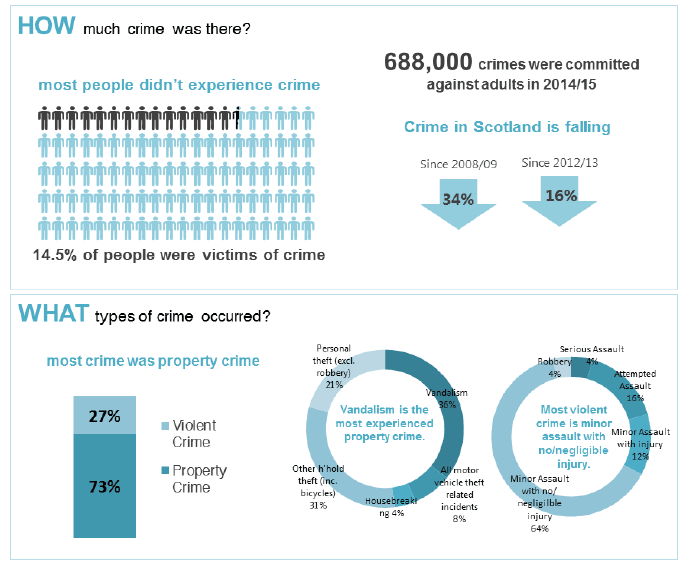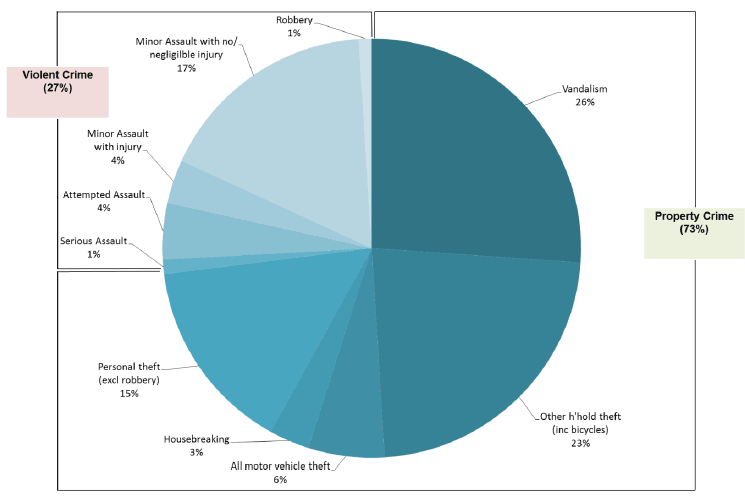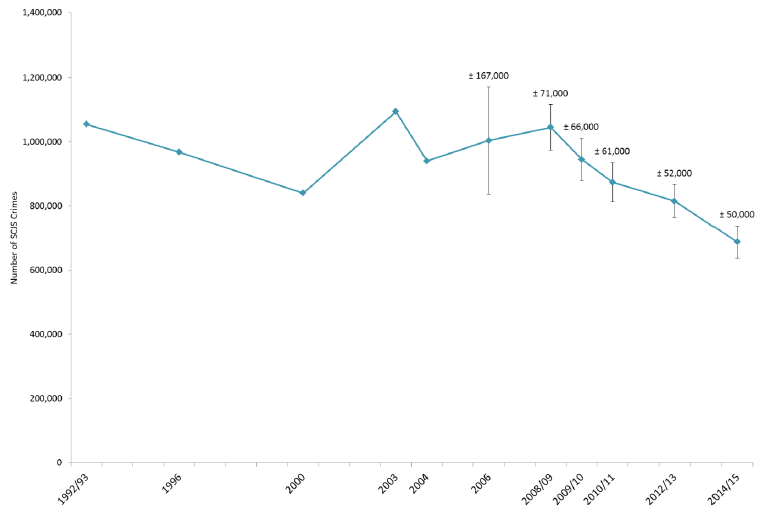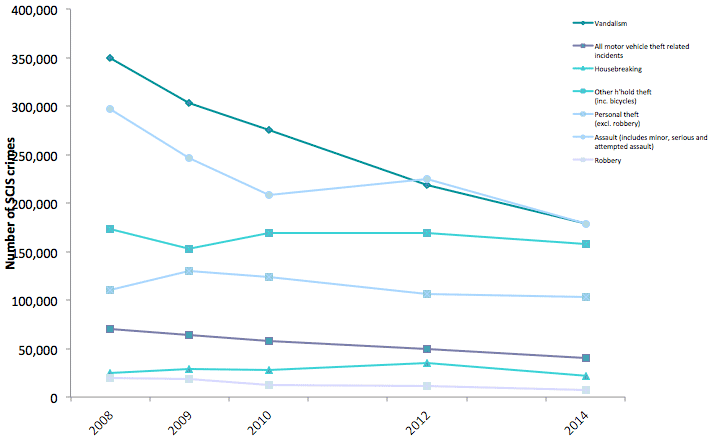Scottish Crime and Justice Survey 2014/15: Main Findings
Main findings from the Scottish Crime and Justice Survey 2014/15.
2. The Extent of Crime in Scotland

2.1. Introduction
This chapter provides an overview of the total number of crimes in Scotland and the proportion of different types of crime within the overall group.
This chapter also compares 2014/15 SCJS results with previous Scottish crime survey results, to present trends over time. Additional context is provided by presenting similar results from the Crime Survey for England and Wales (CSEW).
Box 2.1 Crime Groups
In this report, overall crime measured by the survey has been split into two distinct groups, Property Crime and Violent Crime. As well as being associated with differing levels of risk, crimes within these two groups exhibit different characteristics and victims experience and perceive them differently (see Chapter 4 and Chapter 5).
Property Crime includes the following distinct groups:
- Vandalism (including motor vehicle and property vandalism)
- All motor vehicle theft related incidents (including theft and attempted theft of and from a motor vehicle)
- Housebreaking
- Other household thefts (including bicycle theft)
- Personal theft (excluding robbery)
Violent Crime includes the following distinct groups:
- Assault (includes serious assault, attempted assault, minor assault with no/negligible and minor assault with injury)
- Robbery
2.2. Estimates of Crime
The SCJS provides an estimate of the number of crimes (or incidence) occurring within Scotland. The survey data are then weighted and grossed to an estimate of the total adult population. The figures reported below are rounded to the nearest 1,000 crimes. The SCJS 2014/15 estimates that there were 688,000 crimes against adults resident in private households in Scotland. Of these, 73% (502,000) were property crimes and 27% (186,000) were violent crimes.
The SCJS gathers information from a sample rather than from the whole population. This means that survey results are always estimates, not precise figures, and therefore are subject to a level of uncertainty. To estimate the extent of this uncertainty, 95% confidence intervals for the statistics are calculated to define bands within which the 'true' value of survey estimates are likely to lie (i.e. that value which would be obtained if a census of the entire population was undertaken).
As shown in Annex A Table A1.1, the actual number of crimes in 2014/15 is estimated to be in the range of 638,000 and 738,000 (i.e. 688,000 +/- 50,000). Within this, the number of property crimes is estimated to be between 469,000 and 536,000 (502,000 +/- 33,000) and the number or violent crimes between 150,000 and 221,000 (186,000 +/- 35,000).
2.3. Breakdown of Crime Groups
Figure 2.1 provides a breakdown of the property crime and violent crime groups. The chart shows that almost three-quarters of crime is property crime. Crime is largely made up of vandalism (26%), other household thefts (incl. bicycles) (23%), minor assault with no/negligible injury (17%) and personal theft (excluding robbery) (15%). Since 2008/09, there has been a fairly consistent split between property crime and violent crime. Within the property crime group, however, there has been a decrease in vandalism (from 34% of crime in 2008/09 to 26% in 2014/15) , while other household theft (incl. bicycles) has increased (from 17% of crime in 2008/09 to 23% in 2014/15)[5].
Figure 2.1: Percentage of SCJS crime in each crime group (SCJS 2014/15).

Base: Adults (1,926)
Variable name: OFFENCE
2.4. Comparing Crime over Time
This section presents SCJS results over time, however, mainly focuses on changes between 2008/09 and 2014/15. Care should be taken when comparing estimates from the 2008/09 to 2014/15 surveys with those from previous years. The collection of survey data on crime and victimisation in Scotland has undergone several major changes in methodology which has implications for making comparisons across survey designs. As previous surveys had smaller sample sizes, estimates from earlier surveys are subject to a higher degree of uncertainty. From 2008/09, the SCJS was launched with an increased sample size, a rolling reference period and year-round, continuous fieldwork, until a move to a biennial design following the 2010/11 sweep (as outlined in the introductory section on Survey Background).
2.4.1. Trends in the estimates of Crime in Scotland
The total numbers of crimes estimated by the crime surveys conducted in Scotland since 1992 are presented in Figure 2.2. The smaller confidence intervals (ranges of uncertainty) around the results from 2008/09 onwards are due to the larger sample sizes in these surveys. The confidence intervals around results from the earlier surveys are larger, as demonstrated by the 2006 Scottish Crime and Victimisation Survey (SCVS), but not replicated for years before 2006. The total number of crimes estimated by the 2006 SCVS has wider confidence intervals (+/- 167,000), compared to the most recent SCJS estimate (+/- 50,000).Therefore, the results of surveys since 2008/09 are generally more precise than in previous years. Figure 2.2 shows greater fluctuation in the estimates in earlier years; no clear trend could be detected in overall crime for the surveys conducted prior to 2008.
Figure 2.2 Total number of crimes over time

Base: SCS 1993 (5,030); 1996 (5,050); 2000 (5,060); 2003 (5,040); SCVS 2004 (3,030); 2006 (5,000); SCJS 2008/09 (16,000); 2009/10 (16,040); 2010/11 (13,010); 2012/13 (12,050); 2014/15 (11,500).
SCJS Variable name: INCSURVEYCRIME
Note: There was a break in survey methodology from 2008/09, moving to a rolling reference period, increased sample size and year-round, continuous fieldwork until a move to a biennial design for 2012/13.
The changes over recent years in overall crime and crime sub-groups (as measured by the SCJS since 2008/09) are presented in further detail in Table 2.1 and Table 2.2.
The estimated number of crimes in 2014/15 (688,000) has fallen by around a sixth since the 815,000 crimes estimated in 2012/13, and, by around a third since the 1,045,000 crimes in estimated in 2008/09. Both changes are statistically significant.
Table 2.1 Estimates of all SCJS crime (SCJS 2008/09 to 2014/15)
| Number of SCJS crimes | All SCJS crime | Lower estimate | Upper estimate | Confidence interval | Number of Respondents |
|---|---|---|---|---|---|
| 2008/09 | 1,045,000 | 974,000 | 1,116,000 | 71,000 | 16,000 |
| 2009/10 | 945,000 | 879,000 | 1,012,000 | 66,000 | 16,040 |
| 2010/11 | 874,000 | 813,000 | 935,000 | 61,000 | 13,010 |
| 2012/13 | 815,000 | 761,000 | 867,000 | 52,000 | 12,050 |
| 2014/15 | 688,000 | 638,000 | 738,000 | 50,000 | 11,470 |
Base: All SCJS crime
Variable name: INCSURVEYCRIME
2.4.2. Trends in Crime Groups
Table 2.2 shows the change in estimates in the Property Crime and Violent Crime groups.
Property Crime is estimated to have fallen from 579,000 in 2012/13 to 502,000 in 2014/15 (13%), a statistically significant decrease. The cumulative effect of changes since 2008/09 is also statistically significant, with Property Crime estimated to have fallen by 31% between 2008/09 and 2014/15.
Since 2012/13, Violent Crime showed no real change - the apparent fall from 236,000 in 2012/13 to 186,000 in 2014/15 is not statistically significant. Over the longer term, however, the cumulative effect of these changes shows a 41% decrease in Violent Crime from 317,000 in 2008/09 to 186,000 in 2014/15. This change, over the longer period, is a statistically significant change. Violent crime estimates are based on a relatively small number of respondents (282 in the 2014/15 survey) who had disclosed experiences of violent crime in the survey. As a result, the analysis of results between adjacent survey sweeps may not identify statistically significant changes. However, often, where they exist; the SCJS can identify statistically significant changes over the longer-term.
Figure 2.3 shows the trends in different types of crime since the launch of the SCJS in 2008/09 while table 2.2 highlights which changes are statistically significant. For example, vandalism has fallen from 350,000 in 2008/09 to 179,000 in 2014/15.
Table 2.2 Change in estimates of numbers of all SCJS crime by crime group (SCJS 2008/09 to 2014/15)
| % change | |||||||||
| Crime type | 2008/09 | 2009/10 | 2010/11 | 2012/13 | 2014/15 | 2008/09 to 2014/15 | 2012/13 to 2014/15 | ||
|---|---|---|---|---|---|---|---|---|---|
| ALL SURVEY CRIME | 1,045,000 | 945,000 | 874,000 | 815,000 | 688,000 | -34% | * | -16% | * |
| PROPERTY CRIME | 728,000 | 679,000 | 654,000 | 579,000 | 502,000 | -31% | * | -13% | * |
| Vandalism | 350,000 | 303,000 | 275,000 | 219,000 | 179,000 | -49% | * | -18% | * |
| All motor vehicle theft related incidents | 70,000 | 64,000 | 58,000 | 50,000 | 40,000 | -42% | * | -19% | |
| Housebreaking | 25,000 | 29,000 | 28,000 | 35,000 | 22,000 | -16% | -38% | * | |
| Other h'hold theft (inc. bicycles) | 173,000 | 153,000 | 169,000 | 169,000 | 158,000 | -9% | -7% | ||
| Personal theft (excl. robbery) | 110,000 | 130,000 | 124,000 | 106,000 | 103,000 | -6% | -3% | ||
| VIOLENT CRIME | 317,000 | 266,000 | 220,000 | 236,000 | 186,000 | -41% | * | -21% | |
| Assault | 297,000 | 247,000 | 208,000 | 225,000 | 179,000 | -40% | * | -20% | |
| Robbery | 20,000 | 19,000 | 12,000 | 11,000 | 7,000 | -65% | * | -40% | |
| Number of Respondents | 16,000 | 16,040 | 13,010 | 12,050 | 11,470 | ||||
1. Changes which are statistically significant at the 95% level are highlighted with an "*".
2. It should be noted that some of the equivalent estimates for subgroups of crime, particularly for violent crime, are based on small sample sizes which makes the overall incidence data susceptible to volatile changes following slight changes in underlying violent crime reported by the respondents between sweeps of the survey.
3. Small numbers of records which include larger amounts of repeat incidents of violent crimes can contribute to variation between survey sweeps. For example, the average number of incidents of violent crime (for those that did experience violent crime increased from 3 incidents to 3.3 incidents between 2010/11 and 2012/13).
Figure 2.3 Trends in crime groups[6] (SCJS 2008/09 to 2014/15)

Base: SCJS 2008/09 (16,000); 2009/10 (16,040); 2010/11 (13,010); 2012/13 (12,050); 2014/15 (11, 470)
Variable name: Incidence variables INCSURVEYCRIME[7]
2.5. Comparing with Crime Estimates in England and Wales
Victimisation surveys take place in several other countries[8] to obtain information on their population's experience of crime. However, the methodologies used for sampling, interviewing and analysis often vary, making it difficult to make consistent and valid comparisons between the surveys.
The SCJS is similar to the CSEW[9], with both surveys following on from the British Crime Survey (BCS). In the 1980s, some BCS survey samples covered Scotland, south of the Caledonian Canal. There are differences in the crimes/offence classifications to reflect the differing legal systems, however the overall results from the surveys are broadly comparable.
As noted previously, at an overall level, the SCJS estimates that the risk of crime in Scotland in 2014/15 was 14.5%, lower than the equivalent risk of crime in England and Wales (15.9%).
While this comparison can be made for the overall risk of crime, there are a number differences between the SCJS and CSEW which mean that making comparisons for different types of crime is not straightforward. For example:
- the coding of crimes differs between the SCJS and the CSEW, reflecting the different criminal justice systems in which they operate. One general difference is that the SCJS includes crimes where the offender is a police officer or is mentally ill (these crimes are excluded in the CSEW estimates).
- the SCJS also prioritises assault over other crimes when coding offences. For example, if an incident includes both vandalism and assault, the assault component will be assumed to be more serious unless it is clear that the damage to property was the most serious aspect of the incident.
- unlike the CSEW, the intent of the offender to cause harm is not taken into consideration in the SCJS and the offence code given relies only on the injuries that the victim received.
- the definition of burglary in England and Wales as measured by the CSEW and the definition of housebreaking in Scotland as measured by the SCJS differs.
Contact
Email: Trish Brady-Campbell
There is a problem
Thanks for your feedback